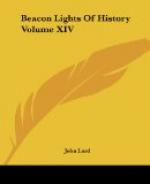No, the roots of Wagner’s music-dramas are not to be found in Beethoven, but in Weber. His “Freischuetz” and “Euryanthe” are the prototypes of Wagner’s operas. The “Freischuetz” is the first masterwork, as Wagner’s operas are the last, up to date, of the romantic school; and it embodies admirably two of the principal characteristics of that school: one, a delight in the demoniac, the supernatural—what the Germans call gruseln; the other, the use of certain instruments, alone or in combination, for the sake of securing peculiar emotional effects. In both these respects Wagner followed in Weber’s footsteps. With the exception of “Rienzi” and “Die Meistersinger,” all of his operas, from the “Flying Dutchman” to “Parsifal,” embody supernatural, mythical, romantic elements; and in the use of novel tone colors for special emotional effects he opened a new wonder-world of sound, to which Weber, however, had given him the key.
“Lohengrin,” the last one of what are usually called Wagner’s “operas,” as distinguished from his “music-dramas” (comprising the last seven of his works), betrays very strongly the influence of Weber’s other masterwork, “Euryanthe.” This opera, indeed, may also be called the direct precursor of Wagner’s music-dramas. It contains eight “leading motives,” which recur thirty times in course of the opera; and the dramatic recitatives are sometimes quite in the “Wagnerian” manner. But the most remarkable thing is that Weber uses language which practically sums up Wagner’s idea of the music-drama. “‘Euryanthe,’” he says, “is a purely dramatic work, which depends for its success solely on the co-operation of the united sister-arts, and is certain to lose its effect if deprived of their assistance.”
When Wagner wrote his essay on “The Music of the Future” for the Parisians (1860) he remembered his obligations to the Dresden idol of his boyhood by calling attention to “the still very noticeable connection” of his early work, “Tannhaeuser,” with “the operas of my predecessors, among whom I name especially Weber,” He might have mentioned others,—Gluck, for instance, who curbed the vanity of the singers, and taught them that they were not “the whole show;” Marschner, whose grewsome “Hans Heiling” Wagner had in mind when he wrote his “Flying Dutchman;” Auber, whose “Masaniello,” with its dumb heroine, taught Wagner the importance and expressiveness of pantomimic music, of which there are such eloquent examples in all his operas. During his three and a half years’ sojourn in Paris, just at the opening of his career as an opera composer (1839-1842), he learned many things regarding operatic scenery, machinery, processions, and details, which he subsequently turned to good account. Even Meyerbeer, the ruler of the musical world in Paris at that time, was not without influence on him, though he had cause to disapprove of him because of his submission to the demands of the fashionable taste of the day, which contrasted so strongly with Wagner’s own courageous defiance of everything inconsistent with his ideals of art. The result to-day—Meyerbeer’s fall and Wagner’s triumph—shows that courage, like honesty, is, in the long run, the best policy, and, like virtue, its own reward.




